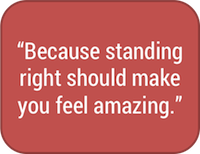 This is the detailed breakout of the troubleshooting portion of the Quitting Sitting Transition Plan. You can view the main index of the plan here, or have it emailed to you, instantly, in full.
This is the detailed breakout of the troubleshooting portion of the Quitting Sitting Transition Plan. You can view the main index of the plan here, or have it emailed to you, instantly, in full.
Sitting is bad, so we switch to standing. But if something goes wrong, standing can be downright painful. We built this transition plan because we were seeing people hurt themselves over and over again.
So this troubleshooting section – even though it’s the end of the plan – was the beginning of our work here. Because these are real problems that real people have. And we need to make those problems a thing of the past.
Standing Desk Problems & How to Fix Them Now
Foot Numbness / Tingling
Foot “falling asleep” and only waking up once you move? These symptoms should always be taken seriously and can be a sign of a serious medical condition. However, this issue is often benign and easily solved.
The Cause
Standers often get “stuck” in one position, forgetting to change stances and postures for extended periods.
When “locked out,” you may be inadvertantly hyperextending your knees and/or putting too much stress on some sensitive nerves at that joint. Specifically the common peroneal nerve, which wraps around the outside portion of your knee can cause irritation and numbness when over stretched or compressed.
The Fix
Try using the above stances and postures to vary leg positioning and relieve this stress. Also check with your medical provider if it is not improving as it could be a sign of a serious condition.
Foot Pain
Are your dogs barking? We’ve heard some pretty rough pain reports from rookie standers.
The Cause
With prolonged standing the arches and heels of the feet can often get quite sore and fatigued. Especially when your standing surface doesn’t support you the right way. The problem isn’t that the floor is too hard, it’s that it doesn’t allow/require enough “micromovement” of the feet and ankles. Overly supportive shoes (think standard bulky running shoes) can cause the same issue.
The Fix
Consider taking a short break from standing to sit and give your feet a rest. Try switching between two different pairs of shoes, ditching the high heels, and adding some barefoot standing to change the pressure points on your feet. Finally, consider investing in an anti-fatigue mat.
Back Pain
The Cause
With any long term change in posture or position at work, aches and pains may develop. In fact maybe you wanted a standing desk to avoid back pain, only to find you have different back pain now. Often when standing, one can put too much extension on the low back creating extra pressure on the spinal joints. A common source of low back pain is over extension of the arms. If your arms are out too far in front of you, your back has to work hard to support the moment (or torque) caused by that load being far from the midline of your body.
The Fix
Check the posture section to learn how to hold a straight / neutral spine while standing, and how to engage your glut muscles to take pressure off the spine. Remember that allowing flexion at the hips rather than the spine is key to proper standing biomechanics.
Leg Fatigue
Theres no doubt that at some point in your transition to a standing desk you will experience leg fatigue. In fact you may feel you’ve hit a plateau where you can’t stand longer than an hour or two. You may feel like a continual need to sit, and find that you’ll even forget to use the standing desk. Don’t be disheartened.
The Cause
A little Occam’s Razor here: if your legs are tired, it’s probably from using them a lot. And that’s good! People who end up tired at the end of the day are normally healthy people. If it feels like you’re experiencing abnormally intense fatigue, it may be the result of moving too little.
The Fix
Remember to keep it moving while you’re standing. Remember to start each work session at the standing desk, then to transition to the sitting desk after you get tired or fatigued from standing. Think of sitting as taking a break from standing – a brief rest and recovery position. When you are refreshed try for another session using the standing desk. Worst case – just stand less for a while. This isn’t a competition, and no one is judging you.
Do you have pain that isn’t listed here? Let us know about it in the comments and we’ll add it to the guide!
Get the full plan, view the plan index, go back to Part 3 or start at Part 1.





[…] to listen to your body and sit when you are fatigued. If you experience any discomfort, see the Troubleshooting section at the end of the […]
I work in a very busy newsroom and have just switched to a standing desk. I am having trouble with knee pain. Any suggestions for that?
Hey Lisa,
Thanks for your comment! Have you checked out any of the suggestions in our transition plan? Tons of great stuff there that should help you out!